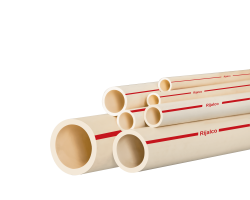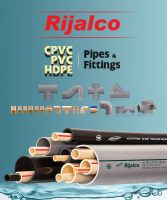Why do people choose Rijalco’s PVC and CPVC?
Summary
The major difference between PVC and CPVC pipes remains the ability to withstand temperature. While PVC pipes support water of fewer than 140 degrees Fahrenheit, CPVC is composed differently and withstands more than 200 Fahrenheit degrees. CPVC pipes supply both extremities of water without breaking or losing their tenacity.
The difference between PVC and CPVC pipes in terms of Composition
The composition of PVC pipes
The essential elements of Polyvinyl chloride (PVC) pipes are derived from oil and salt. These thermoplastic materials come with a wide range of usage. The vinyl chloride monomer (obtained from oil) is combined with Chlorine (derived from the electrolysis of saltwater). The molecule of vinyl chloride is C2H3Cl.
Chlorinated Polyvinyl Chloride (CPVC)
The composition of CPVC differs from PVC pipes. The difference between PVC and CPVC pipes is that CPVC is a chlorinated form of PVC pipes. It is a thermoplastic derived by the chlorination of PVC resin again. The chemical composition of CPVC pipes is two carbon atoms bonded with each other than with two other hydrogen atoms and then again two chlorine atoms on this double unit. Thus, the molecular chain links with others to finally form CPVC pipes. However, this does not mean the pipes are toxic. The pipes being toxic is a common misconception. Both PVC and CPVC pipes are non-toxic in nature and are safe for the transport of drinking water as well. The difference between PVC and CPVC pipes is their chemical composition.
The difference between PVC and CPVC pipes in terms of Benefits
Benefits of using PVC pipes
This is the most common PVC water pipe found in daily use. These pipes are Unplasticized and
therefore very rigid in form. However, their durability makes them useful for all kinds of transportation of water as pipes and fittings. Moreover, the PVC pipes are used for sewage and industrial purposes as well. These pipes are the best choice for any transportation of drinking water as they are more than safe.
PVC pipes also remain unaffected by strong UV rays thus making it a wonderful option for underground water supply. Its durability and strength are so high that it can be used for over a century. Due to their chemical formation, these pipes are recyclable. Therefore, PVC pipes are
good for both us and the environment.
Rijalco has PVC pipes that retain all the good properties of PVC including high durability and cost-effectiveness.
Why use PVC instead of CPVC?
There are a few reasons to choose PVC instead of CPVC pipes.
a. Mostly for normal usage
The PVC pipes are found everywhere. Every household and commercial usage has PVC pipes. These versatile pipes have their own fittings. They can be used for every underwater water supply.
b. Cost-effectiveness
PVC pipes are cheaper than CPVC. They are more cost-friendly than CPVC pipes. RIjalco has a very cost-effective solution of PVC pipes for every project.
c. Durability
PVC pipes remain one of the most durable pipes in the market. These durable pipes have strong tenacity. Once installed, they give a timeline of more than 100 years easily. They must not be exposed to sunlight, however.
Benefits of using CPVC pipes
CPVC water pipes or Chlorinated Polyvinyl Chlorine pipes are the reformed versions of the already advantageous PVC pipes. CPVC retains all the good qualities of PVC pipes including high durability, safe for drinking water transportation, and does not affect UV rays. Additionally, CPVC water pipes withstand high and low temperatures. While PVC pipes can only withstand temperatures below 200 Fahrenheit, CPVC has a larger margin in that arena. Therefore, CPVC is the best pipe for underground drinking water supply. These modified PVC pipes have been used widely over the last decade. Their durability is a testament to their efficiency and utility. CPVC is also 100% recyclable making it the best water pipe in Nepal. Rijalco CPVC pipes have long been used for proper transportation of drinking water that is safe.
The Rijalco pipes go through rigorous testing to assure quality. Thus, all of Rijalco’s pipes have been above the standard for a long time.
Why use CPVC instead of PVC?
There are a few reasons why you can use CPVC pipes instead of PVC pipes.
a. Ability to withstand high temperature
CPVC pipes can withstand up to 200 degrees of Fahrenheit of water than PVC pipes. PVC
pipes are able to withstand only 140 Fahrenheit degrees of water. Thus, it is not possible to
transport hot water with it.
b. Projects in hot and humid temperature
Projects in hot temperatures may have long exposure to high temperatures. Such projects
require the tenacity of CPVC pipes.
c. Cost-effectiveness
When thinking about cost-effectiveness, installing more durable and resistant CPVC pipes will
reduce the chances of damage. Thus, it will help prevent maintenance costs.
d. Ability to withstand UV light rays
CPVC can withstand UV light rays, unlike PVC pipes. This is one of the biggest differences
between PVC and CPVC pipes. Due to this reason, CPVC pipes can be used. It will not damage
easily even when exposed to the surface.
Other Types of PVC Pipes in the Market
Polymerized pipes are the most widely used pipes in the market. Currently, almost every
household in Nepal uses some form of PVC pipe for transportation of both normal water and
drinking water. The types of PVC pipes depend upon their chemical formation. This ultimately
also differentiates their utility and use.
PVC-O water pipe
These pipes are used as underground water pipes with the best ability to sustain pressure. In
areas requiring irrigation, PVC-O is used most of the time. PVC-O is a molecularly altered
version of PVC-U which turns the unplasticized PVCs into a layer structure. In a sense, PVC-Os
are highly resistant in addition to the already sturdiness of PVC-Us. Moreover, much like PVC-U
and CPVC pipes, PVC-Os pipes and fittings are recyclable in nature. Thus, these pipes retain
tenacity and fatigue resistance. It means that the PVC-O works best for highly pressurized water
sources. Nevertheless, they have been long used for sewer pumping as well.
Modified PVC
Modified PVC falls under the thermoplastic family which has been composed by adding
modifying agents to PVCs. These agents strengthen the PVC pipes, making them even tougher
and highly resistant to cracks. The modifying agents even make these pipes thinner, more
efficient, and resistant to scratches. Modified PVCs, mostly PVC-HI have been long used
against impact blows. These types of modified PVCs are found in the Netherlands where they
transport hydrogen gas. As clean and green energy rises in Europe, PVC-HIs have been
consistently rising in popularity to transport hydrogen gas. These have potential in the Nepalese
market to give rise to alternative fuel sources.
Conclusion
After careful observation, it can be found that there are only a few differences between PVC and
CPVC pipes. These differences are nominal. In any case, both pipes are used for similar and
different projects. It is up to the user and their project to determine the best one. All in all, Rijalco
provides both PVC and CPVC pipes. Under any confusion, customers can still consult our
customer service to choose the best fitting pipes and understand the difference between PVC
and CPVC pipes.
Which is better: PVC or CPVC?
The answer is both but it depends upon what you are looking for. If you are looking for standard
usage for residential projects, PVC pipes are better. They are much cheaper and are found
easily in the market. Their durability is high and does not break easily. On the other hand, CPVC
pipes withstand a much higher degree of temperature. If you are looking for pipes for projects
involving hot water or in hot areas, CPVC is the best option. Thus, it depends upon your
preference.
FAQs
Should I use PVC or CPVC?
First, identify what kind of project you want the pipe for. If it is for normal and daily use water
supply pipes in a mild temperature area, PVC pipes should be used. They are relatively cheaper
than most other pipes in the market. Moreover, they showcase the greatest durability and
strength. Once you install underground PVC pipes, you probably have 100 years before you
need to change them. Hence, if that is what you’re looking for, use PVC pipes.
However, if your projects require handling of water in hot areas and underground supply of hot
water, choose CPVC pipes. CPVC pipes withstand a much higher degree of temperature than
normal PVC pipes. Therefore, it is important to see what project you are working on to choose
between PVC and CPVC pipes.
Which is stronger: PVC or CPVC pipes?
Arguably, CPVC pipes are much stronger than PVC pipes. Both are polyvinyl chlorine pipes
however, CPVC pipes are also Chlorinated. They are highly reformed versions of already
advantageous PVC pipes. Many industrial and commercial projects use CPVC pipes for
underground water supply. Due to its modified nature, CPVC is a bit stronger and more durable
than normal PVC pipes





